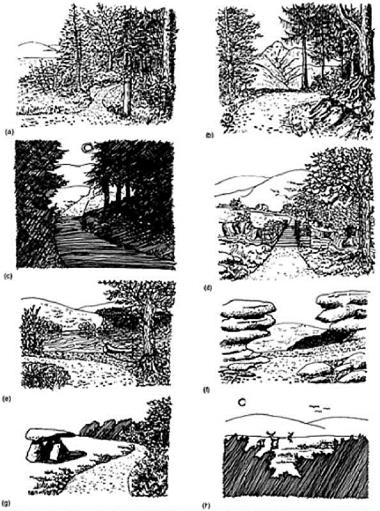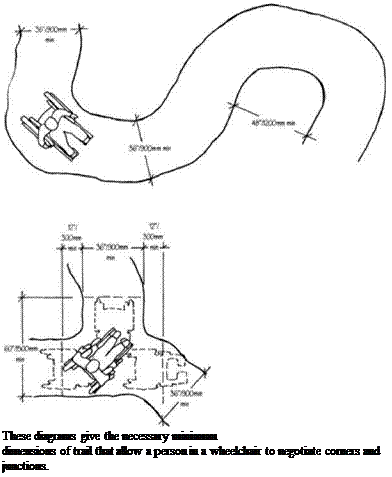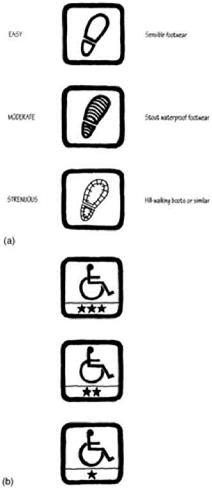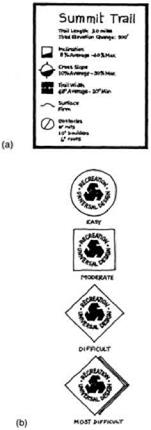Once the route of the trail has been selected, it should be cleared, gradients found for barrier-free access (see below) where these are needed, and decisions made on appropriate surfacing.
There are some guidelines to follow when considering trail construction:
– Build as little surfaced trail as possible, if the ground is hard, naturally well drained and can withstand the expected traffic.
– Avoid steps and ramps if possible. This is obligatory on barrier-free trails, and is a general principle to follow elsewhere. Use short, steep pitches if needed in the more rugged places, but generally try to find suitable gradients for comfortable walking.
– Keep paths away from wet and soft ground, especially silt, clay or peat soils if possible. Erosion of exposed soil during rain and attempts by people to walk round muddy places exacerbate soil removal and create unsightly scars.
– Try to avoid routes crossing scree or talus slopes or heavy boulder fields. These can be loose, dangerous and difficult to stabilize.
In places where these guidelines cannot be followed, the construction of firm, dry, well-drained surfaces is necessary. The degree of finish that these should be given will depend on the wildness of the landscape, the fragility of the surface to be crossed, the expected amount of use, the availability of materials and the resources available for construction and maintenance.
The standard of construction depends on the kind of trail required. If it is to be used by everyone, including people with disabilities, then a different specification will be appropriate from that expected to be used by fit, energetic people who are well equipped with hiking boots. It is possible to categorize trails as follows.
– Barrier free: easily accessible to wheelchairs, pushchairs (strollers), visually impaired visitors and those with walking difficulties. All-weather surfacing, low gradients (not more than 1 in 12 for short stretches only) and no steps are required for such trails, which should be capable of being walked wearing light shoes.
 |
This set of sketches suggests how a sequence of features can be linked together to give an exciting experience when following a trail: (a) The threshold to the trail should be well marked and inviting, the path leading the walker and giving a sense of direction. (b) A slot view out of the foreground, here sited on a curve for maximum impact and effect. (c) The trail emerges from a dark, tunnel-like space, revealing a sunny open area beyond, increasing the feeling of
movement through the landscape and of
anticipation. (d) A water crossing will always be an attractive and significant feature where sound, light and movement occur together. (e) Access to a small lake is usually important and worth including, (f Curious or unique geological features such as wind – sculpted rocks lend a sense of mystery and admiration at the forces of nature.
(g) Archaeological or historical sites help to connect people with past human use or associations, and also demonstrate the capacity of nature to reabsorb our efforts. (h) A chance to see some wildlife can be a rare thrill for many people. The trail should maximize opportunities without causing alarm to the wildlife or risk to the viewers.
– Easy: good conditions underfoot, gentle slopes, short steep sections or occasional flights of steps if absolutely necessary. Sensible footwear such as stout shoes would normally be needed.
– Moderate: some rough places, wet surfaces in parts, some larger sections of steep grades up and down. Wellington boots or hiking boots are desirable, especially in wetter climates and colder seasons.
– Strenuous: rough conditions underfoot and steep slopes, making hiking boots essential. Where paths lead to higher altitudes there may be sudden changes in weather. Above the tree-line the path may be difficult to detect, and so map and compass skills are likely to be needed. These types of routes include mountain paths, long-distance trails, miners’ and stalkers’ paths.
Beyond these categories come routes that demand greater physical fitness, stamina and special equipment, and so are beyond the scope of this discussion.
Once the trail has been categorized, a specification can be developed for an appropriate type of surface. This is most important for trails intended for use by people with disabilities (barrier-free). To enable less able people to choose trails suited to their individual capabilities, a star-rating system has been devised by the British Forestry Commission based on surface
|
(a) The symbols make it clear as to what kind of trail conditions a walker can expect. (b) These symbols help people with disabilities to decide whether they want to attempt a particular trail Both sets of symbols are used by Forest Enterprise in Britain. |
criteria set out by the Royal Association for Disability and
Rehabilitation:
– Three stars indicates a walk with gradients no greater than 1
in 40 (up to 1 in 20 for lengths no longer than 10 m/11 yd)
and with a smooth, hard surface without obstruction or potholes.
– Two stars indicates a walk with gradients up to 1 in 20 for stretches no longer than 100 m/111 yd and with a smooth, hard surface with few obstructions or potholes.
|
These symbols are used in the USA: (a) A useful way of showing the actual trail conditions for anyone to decide whether they want to follow it. (b) Symbols showing the grading system— the graphics are clumsy compared with the British example on the left. |
– One star indicates a walk with gradients of up to 1 in 12 for stretches no longer than 20 m/22 yd and with sections of irregular surface no longer, than 5 m/5.3 yd.
 |
Although building as little trail as possible is preferable when construction is needed, it should be to the highest standard possible. This is because poorly constructed trails using inferior materials are unlikely to last long in the exposed, harsh conditions to be found in the outdoors. When they fail, such surfaces are difficult to repair adequately and become a drain on maintenance budgets.





